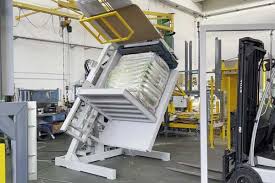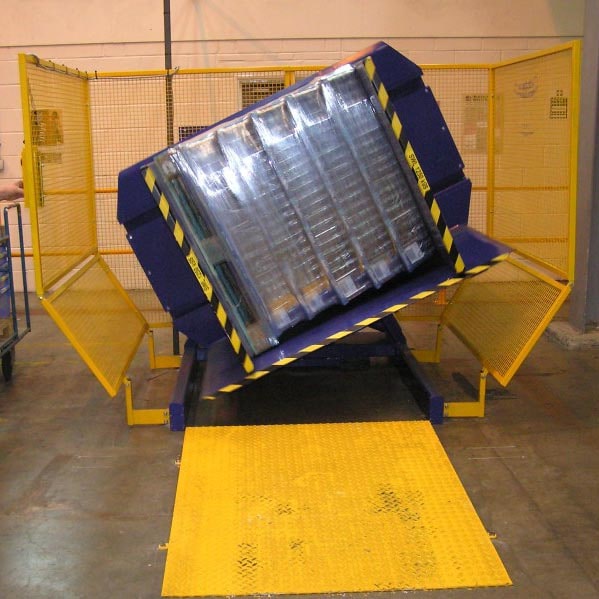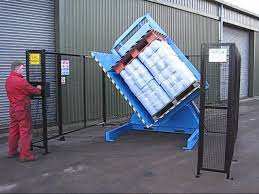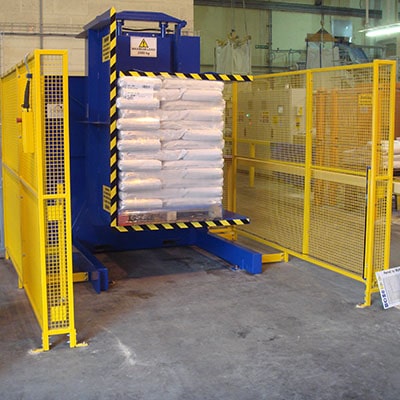Your Custom Mold Flipper Solution: From Design to Installation
Handling massive, heavy molds in a steel mill is a daily challenge. I have seen it many times. Using old, outdated equipment for this critical task is not just inefficient; it is dangerous. You worry about unexpected breakdowns that halt production. You worry about the safety of your team. Every minute of downtime caused by a slow or failed mold change cuts directly into your profits and creates stress that ripples through the entire plant. This constant risk of failure from aging machinery makes it difficult to plan your production schedule with confidence. You know there has to be a better way, a more reliable solution that fits your specific needs. The answer is a custom-designed mold flipper, engineered specifically for your facility. It is a solution built around your workflow, from the initial design concept all the way through to a professional, seamless installation on your factory floor.
A custom mold flipper solution involves a comprehensive process that begins with a deep analysis of your specific operational requirements. It then moves through collaborative engineering design and meticulous manufacturing. The process concludes with professional on-site installation and commissioning by an expert team. This complete, end-to-end approach ensures the final equipment integrates perfectly with your existing workflow, enhances operational safety, and delivers a clear and powerful return on your investment.

This all sounds good, but you need to know how it works in reality. As an engineer myself, I respect the need for practical details, not just promises. So, let’s walk through each critical stage of the process. I want to show you exactly how we take the challenges you face every day and transform them into a reliable, powerful asset for your mill. This is about building a solution together.
How Does a Custom Design Process Address Your Specific Operational Needs?
You run a unique operation. Your molds have specific dimensions and weights. Your plant has a specific layout with its own traffic patterns and space constraints. A standard, off-the-shelf machine simply cannot account for these critical variables. Trying to force a generic piece of equipment into your specialized environment almost always leads to compromises. It can create new bottlenecks in your material flow, require extra manual handling that slows things down, or even introduce unforeseen safety gaps. These compromises completely undermine the efficiency and safety you are trying to achieve with your investment. A custom design process flips this entire approach. We start with your needs first. We build the solution around your operation, not the other way around. This ensures a perfect fit and a machine that works for you, not against you.
A custom design process addresses your specific operational needs by translating your unique requirements into a detailed engineering blueprint. These requirements include everything from mold dimensions and weight to your plant layout, power supply, and specific safety standards. This collaborative approach ensures the final mold flipper integrates seamlessly into your facility, enhances your existing workflow, and meets every one of your performance and safety targets from day one.

The Initial Consultation: Understanding Your World
The first step is the most important. It is not about selling you a machine; it is about listening and understanding. I have spent countless hours on factory floors, just like yours. I remember visiting a steel plant in Mexico a few years ago. The general manager, a man much like Javier, walked me through his casting area. He did not just show me the old flipper; he showed me the inefficient path the crane had to take, the two extra people required to guide the mold, and the minutes lost with every single change. Seeing the problem with my own eyes is essential. This is why our process begins with a detailed consultation. We gather all the necessary data: the exact specifications of your molds, your target cycle times, the physical space constraints, the available power supply, and your internal and government-mandated safety regulations. This is the foundation upon which we build everything else.
Collaborative Engineering and 3D Modeling
Once we understand your world, our engineers get to work. We take all that data and create a detailed proposal, complete with 3D models. This is a critical, collaborative phase. You get to see the machine, virtually, inside your plant layout before a single piece of steel is cut. You can see how it interacts with your cranes, where the operator will stand, and how it fits into the material flow. This visual verification is powerful. It allows your team to provide feedback and request adjustments early in the process. Maybe the control panel would be better on the other side. Perhaps a slight change in the rotation angle would improve crane access. We can make these changes easily in the model. This proactive approach prevents costly and time-consuming problems during installation. It aligns with a core engineering principle: measure twice, cut once. For a business leader focused on ROI, this process de-risks the entire project.
| Feature | Standard "Off-the-Shelf" Flipper | SHJLPACK Custom Flipper Solution |
|---|---|---|
| Fit & Integration | General purpose; often requires you to modify your plant or process. | Precisely tailored to your layout, molds, and workflow. |
| Operational Efficiency | Can create bottlenecks or require extra manual steps. | Optimized for your specific cycle time and material flow. |
| Safety Compliance | Basic safety features; may not address site-specific risks. | Integrates with your existing safety systems and protocols. |
| Equipment Interface | May have compatibility issues with your cranes and transport. | Designed for seamless connection with your other equipment. |
| Return on Investment | Lower upfront cost, but potential for hidden long-term costs. | Higher initial investment, but maximized for long-term reliability. |
What Role Does Factory Acceptance Testing (FAT) Play in Ensuring a Smooth Installation?
You have approved the design and made a significant investment. Now, the biggest concern becomes whether the machine will perform as promised when it arrives at your mill. The nightmare scenario for any plant owner is discovering a major problem during on-site installation. A mechanical issue or a software bug found at this stage means chaos. It leads to unexpected downtime, expensive travel for engineers, and project delays that cost you real money every single day your production line is not running at full capacity. The Factory Acceptance Test, or FAT, is our shared insurance policy against this risk. We build, assemble, and test your machine completely in our factory, with you and your team present, to find and solve any potential problems before they ever reach your property.
A Factory Acceptance Test (FAT) plays a critical role by allowing you to inspect and test your custom mold flipper at our manufacturing facility before it ships. This crucial pre-installation verification ensures all mechanical structures, electrical systems, and control programs function according to the agreed-upon specifications. This process catches potential issues early, building confidence and guaranteeing a much faster and smoother on-site installation at your facility.

More Than Just a Power-On Test
A proper FAT is far more than just plugging the machine in and watching it turn. It is a comprehensive simulation of real-world operating conditions. We use test weights that are equivalent to your heaviest molds to verify the structural integrity and motor capacity. We run the machine through dozens of cycles to check for consistency and smoothness in its operation. We test every single sensor, every emergency stop button, and every safety interlock to ensure they function instantly and correctly. Our programmers will walk you through the control software, demonstrating every function and failsafe. We check the weld quality, the alignment of all moving parts, and the finish of the machine. This detailed process is designed to find any deviation from the design specifications so we can correct it in the controlled environment of our own workshop. This rigor is what separates a reliable partner from a simple vendor.
Your Team's Involvement is Key
I always insist that my clients bring their own teams to the FAT. This includes the engineers who will oversee the machine, the maintenance staff who will care for it, and the operators who will use it every day. This is their first opportunity to get hands-on with the exact piece of equipment they will be working with. They can ask questions directly to the people who built it. They can suggest minor adjustments to the HMI (Human-Machine Interface) to make it more intuitive for their workflow. This involvement is invaluable. It builds a sense of ownership and familiarity before the machine even leaves our factory. It also serves as the first stage of training, which drastically speeds up the learning curve and commissioning process once the flipper is installed on-site. This collaborative step helps transform the installation from a simple delivery into a smooth integration.
| Test Category | What We Check | Why It Matters for You |
|---|---|---|
| Mechanical Integrity | Structure, welds, rotation smoothness, drive system, alignment. | Ensures long-term durability and prevents premature wear. |
| Electrical & Controls | PLC logic, sensor accuracy, HMI response, wiring, cabinet layout. | Guarantees reliable, predictable operation and easy maintenance. |
| Safety Systems | Emergency stops, light curtains, safety interlocks, alarms. | Confirms the machine meets all safety standards to protect your people. |
| Performance | Cycle time, rotation speed, load capacity (with test weights). | Verifies the machine meets the performance goals we agreed on. |
How Can a Turnkey Installation Service Minimize Disruption to Your Mill's Operations?
The new mold flipper has been built, tested, and has just arrived at your plant. Now the real work begins: installing it without causing a major shutdown of your production. A poorly managed installation can quickly descend into chaos. Trying to coordinate different contractors for mechanical assembly, electrical wiring, and software integration is a major headache. Miscommunication is common, delays are frequent, and every hour of lost production hits your bottom line directly. This is a level of stress and risk that no plant owner needs. A turnkey installation service eliminates these problems. It means you have one team, one single point of contact, and one party with total responsibility. We handle everything from uncrating the machine to the final handover, working efficiently within a planned schedule to get you back to full production as quickly as possible.
A turnkey installation service minimizes disruption by providing a single, expert team responsible for the entire on-site process. This includes mechanical assembly, electrical hookup, integration with your existing systems, and final commissioning. This streamlined project management avoids the coordination problems and delays that come from using multiple vendors. It allows us to stick to a strict timeline and ensures your new mold flipper is fully operational with the absolute minimum impact on your ongoing production.

The Power of a Single, Coordinated Team
Imagine the difference. With a self-managed installation, you are the project manager. You have to sync the schedules of the mechanical riggers, the electricians, and the control engineers. If the riggers are a day late, the electricians are sitting idle, but you still have to pay them. If the electricians wire something incorrectly, the control engineer might spend a day troubleshooting a problem that is not their fault. It can become a cycle of blame and delays. With our turnkey service, that entire burden is gone. Our team consists of the very same people who designed and built the machine. The mechanical lead knows exactly what the electrical lead needs. The programmer who wrote the code is there on-site to commission it. It is a coordinated effort, where everyone understands their role and how it connects to the next step. We work as one unified team with one goal: to get your machine installed safely and efficiently.
Planning is Everything: The Installation Schedule
A successful installation begins long before our team arrives. We work closely with your production and maintenance managers to create a detailed installation plan. Our primary goal is to fit into your schedule. If you have a planned maintenance shutdown, we will schedule the core installation work to happen then. We do as much pre-assembly and preparation as possible to minimize the time we need on the main production floor. We map out every step, from the moment the truck arrives to the final operator training session. This meticulous planning ensures that when our team is on-site, they are working, not waiting. This approach is fundamental to respecting your operational needs and achieving your goal of maximum equipment uptime. A smooth installation is not an accident; it is the result of careful, collaborative planning.
| Phase | Self-Managed Installation | SHJLPACK Turnkey Service |
|---|---|---|
| Planning | You must coordinate multiple contractors and create the schedule. | We create a single, detailed, and integrated plan with you. |
| Execution | High risk of miscommunication and delays between vendor teams. | Our single, experienced team works in complete unison. |
| Troubleshooting | Blame can be shifted between contractors, causing more delays. | We own every problem and solve it quickly. One point of contact. |
| Timeline | High risk of schedule overruns and extended production downtime. | Focused on meeting the agreed timeline to minimize production loss. |
| Outcome | A functional machine, but often after significant stress and delay. | A fully commissioned system, handed over with your team trained. |
What Are My Insights on a True Partnership for Your Mold Flipper Project?
You need to buy a new piece of equipment. There are many companies in the world that can sell you a machine. You can get quotes, compare features, and make a purchase. But a simple transaction is not a relationship. When an unexpected issue arises two or three years down the road, will that "supplier" still be there for you? Will they understand the history of your machine and your operational priorities? Or will you be left on your own with a technical manual and a customer service number that leads nowhere? This is the fear of every owner who invests in critical equipment. From my perspective, a true partnership must go far beyond the initial sale. It is about a shared, long-term commitment to your success. It is the core principle I used when I built my own company.
My insight is that a true partnership for your mold flipper project is not about a single transaction; it is a long-term commitment. It means we act as an extension of your own engineering team. We provide expert advice on technology, support you through maintenance and future upgrades, and actively share our knowledge to help your business grow and thrive in a competitive market.

From Factory Floor to Factory Owner
My journey in this industry began as an engineer on the factory floor. I know the frustration of dealing with equipment suppliers who are great at making promises but disappear after they get paid. I remember the feeling of being stranded with a machine that was not performing as it should, with no one to call for real support. When I started SHJLPACK, I made a promise to myself and to every client I would ever work with. I would build the kind of company that I always wished I could have partnered with back then. This experience is the bedrock of our philosophy. I understand the path of growing a business from the ground up, and I have immense respect for leaders like Javier who have done the same. This shared perspective is why we focus on partnerships, not just sales.
Beyond the Installation: Long-Term Support
Our relationship does not end when your new mold flipper is commissioned. That is when it truly begins. A true partnership means we are there for you for the entire life of the equipment. It means having a reliable source for spare parts. It means providing remote diagnostic support, where our engineers can log into your machine's PLC to help your team troubleshoot an issue in real-time. It means working with you to develop a predictive maintenance schedule to maximize uptime, a goal I know is critical for you. It also means being a resource you can call when you face new challenges, whether it is integrating your equipment with a new MES system for your digital transformation, or adapting to new environmental standards. When you call us in five years, we will know your machine, your history, and your goals. We are in it for the long haul.
Sharing Knowledge to Help You Grow
I was able to achieve financial independence and build a successful business because other people in this industry were generous enough to share their knowledge with me. They taught me, challenged me, and supported me. Now, it is my mission to do the same for others. This is why SHJLPACK is also a knowledge-sharing platform. A partnership with us means you get more than just a machine. You get access to our decades of expertise in packaging and material handling. We can be a sounding board for new ideas, discuss emerging technologies for energy savings, or help you analyze and improve your entire end-of-line packaging process. We believe that by helping our clients become more successful, we all succeed together.
Conclusion
A custom mold flipper is more than a machine. It's a partnership, a process, and a powerful step towards a safer, more efficient, and more profitable operation.



